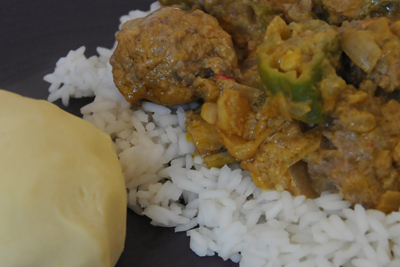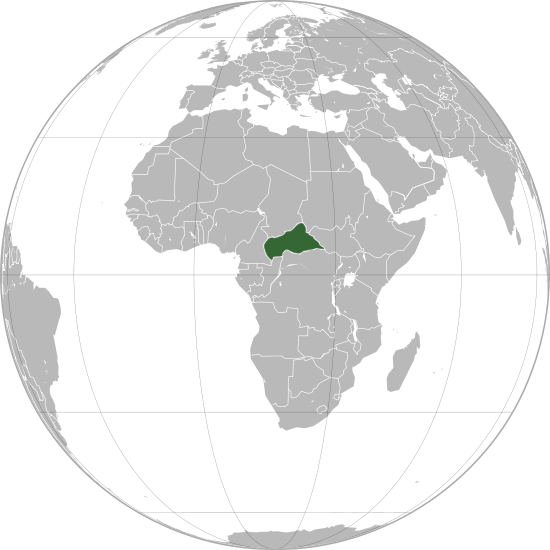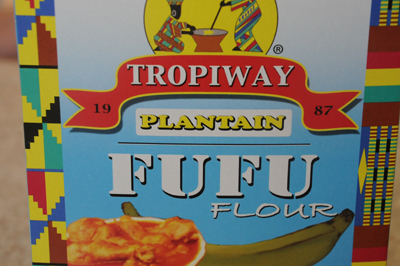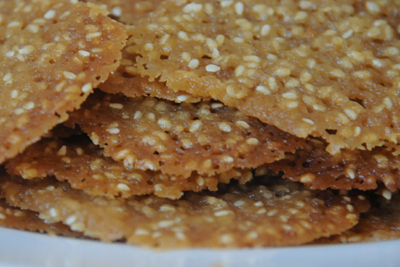A disadvantage, of course, is that if I hate one of the recipes that blogger suggested, I then have to worry that I'm going to offend that person when I post my verdict of the meal (this hasn't actually happened yet, fortunately). I know, I know, I shouldn't worry. Restaurant critics sure as hell don't care whether or not they offend someone. But I'm not a restaurant critic, so I do worry—especially if it's a person who has gone out of his way to help me.
Which is why it's good that this week's meal didn't come from a blogger. Because "yawn" and "bleh." And I'll throw in a "blah" for good measure.
 |
| It looks pretty good, doesn't it? Haha. |
Now, I probably was just unlucky. There are no bloggers out there writing about food in Central Africa, or if there are they need to consider taking a course on SEO (so do I, but there you go). There also do not seem to be any books on the subject, unless you count Recipes for the Specific Carbohydrate Diet: The Grain-Free, Lactose-Free, Sugar-Free Solution to IBD, Celiac Disease, Autism, Cystic Fibrosis, and Other Health Conditions, which oddly enough was the very first hit on Amazon.com when I tried to search for "Central African Recipes." So I was stuck with the usual questionable pickins from Celtnet and the like, and even in those places there just weren't a lot of choices.
So before I reveal my enormously unexciting menu, let me just tell you a little bit about the country where these recipes (presumably) came from. The Central African Republic is, as you might have guessed, located in pretty much the exact center of the African continent. With 240,000 square miles and 4.4 million citizens, it is neither small nor large, and unlike many other African nations it has significant mineral resources such as uranium, gold, diamonds, crude oil and lumber. Sadly, the average Centrafrican doesn't really benefit from the sale of these resources, and the country remains the sixth poorest nation in the world, with a Human Development Index that ranks 179th out of 187 nations.

So the absence of Centrafrican bloggers is unsurprising, really, and I'm sure that the recipes I made aren't really representative of what Central Africa has to offer. I would be happy to do this one over if I find some better recipes somewhere down the road. But in the meantime, here's what I did:
Kanda ti Nyma (Meatballs in Peanut Sauce)
- 1 lb ground beef
- 2 large onions, finely chopped
- 2 eggs, beaten
- 1 chilli, finely chopped
- 2 garlic cloves, finely chopped
- 2 tbsp palm oil or groundnut oil
- 2 cups frozen cut okra
- 1/2 cup unsweetened peanut butter
- 1 cup warm water
Fufu
- 1/2 cup fufu flour
- 1 cup water
Benne Wafers
- 1 cup sesame seeds, toasted
- 3/4 cup butter, melted
- 1 1/2 cups brown sugar, packed
- 1 egg
- 1 tsp vanilla extract
- 1 cup all-purpose flour
- 1/4 tsp salt
- 1/4 tsp baking powder
First mix the ground beef with half of one onion, the chili pepper, garlic and eggs. Shape into balls and cover. Put in the fridge for an hour or so, or until they set.

Now heat the oil over a medium flame and fry the onion until it starts to turn brown. Add the okra and continue to fry for five or 10 minutes.

Meanwhile, blend the peanut butter with the water and add to the pan. Return the pot to a simmer, then add the meatballs.

Cook for 25 minutes, turning the meatballs once. The okra should be tender and the meatballs should be cooked through. Serve over rice.

Now on to the fufu. The first burning question I know you have is this, "why in the hell would you want to make fufu?" Well, here's the reason. I kept seeing it referred to on Caribbean and African food websites. It seems to be very popular, so there must be something to it, right? And also I found a box of fufu flour at Red Star International the last time I was there, so I bought it.
 |
| In my defense, when I bought this I didn't yet know quite how much I hated plantains. |
What is fufu flour, you ask? Well, as it turns out, this particular variety was a blend of flours made from yep, you guessed it, cassava. And also one of my two arch nemeses, plantains. Yay.
So here's how you make fufu:
Boil the water. Add half of it to the flour and mix. Then slowly add the other half. Knead until you get a big shiny ball of dough. Done.

Finally, the dessert.
Start by heating your oven to 375 degrees. Meanwhile, toast your sesame seeds. Now, the original recipe said to put them in the oven on an ungreased baking sheet for 10 to 12 minutes, but that sounded fraught with peril. I've burned many a pine-nut that way. I found it much easier to control the process by doing it on the stove top—just heat a dry pan and add the sesame seeds, stirring constantly until they start to turn a light shade of brown. Remove them from the heat and transfer to a small bowl.

Now mix all the rest of the ingredients together and add the sesame seeds.

Grease a baking sheet. Drop the dough by half-teaspoons onto the sheet, making sure to keep some distance between each wafer. When baking, the wafers will spread out until they're pretty much flat, so they need a lot of space on the pan.

Bake for 5-6 minutes, or until the edges of each wafer start to brown. Remove from the oven and let sit for 2-3 minutes. Transfer to a wire rack to cool (if you wait much longer they will start to stick to the pan).

OK. So as I'm sure you've guessed from previous paragraphs, the kanda ti nyma was bland. Which was shocking, because I don't think I've ever eaten anything made with peanut sauce that I didn't think was delicious. But this really had no flavor, except for the overpowering flavor of unsalted, unsweetened peanuts. It desperately needed some spice or a little salt to liven it up. It was certainly edible, but boring. Really boring. And of course there was the addition of the okra, which I'm really not crazy about. Okra cook up slimy, which I find unpleasant. So overall this dish didn't do it for me at all.
As for the fufu, well, what can I say about the fufu. It was awful. Martin stared at it for about five minutes before he tried it. First he said, "Um, are you sure you made it right?" I told him I followed the package directions exactly. Then he took a bite of it and said "Are you SURE you made it right?" What did it taste like? Well, it was just a big ball of raw dough that tasted pretty much exactly like how you'd expect plantain flour to taste. And the sauce from the main dish of course didn't help at all, because it was equally as bland.
My kids, however (especially Dylan) did find some use for it. Remember that scene in Close Encounters of the Third Kind where the guy makes the Devil's Tower out of mashed potatoes? Yeah, it was like that only with fufu.
Now the meal did have a saving grace, and that was the benne wafers. They were wonderfully unique. They turned out crispy and the sesame seeds gave them a great texture and flavor. My kids all loved them, but their biggest fan was 2 1/2 year old Henry. In fact, I'm pretty sure Henry has never met a food he liked as much as he liked those wafers. He liked them so much that he went into the kitchen and positioned himself between the plate full of leftover wafers and anyone who dared challenge him. He was like a dog standing over its dead master. "Mohwee cewkie! Mohwee cewkie!" (Henrese for "more cookie"). And I won't even get into the details on the dickie fit he threw when I wouldn't let him have any more.
The sad truth is, though, that I don't really even know if these wafers are truly a Central African Republic recipe. I've seen them in other places just called "African benne wafers," so I can't say for sure if they even belonged on this week's menu.
Well, what can I say, I made the effort. Not every week can be a winner.
UPDATE: Thank you to Deborah Troester, a reader who lives in the Central African Republic, for suggestions on how to improve the Kanda ti Nyma. Deborah suggests serving this dish with the traditional hot pepper powder, which would be sprinkled over the sauce before eating. She also says that Centrafricans who can afford it will add salt when it is available. Next week: Central Canada
For printable versions of this week's recipes:











What a wonderful concept and I loved this post. I didn't love the food so much. I too love anything in a peanut sauce but bland peanut sauce doesn't excite me at all. I hope you'll consider doing a guest post on orgasmicchef.com for me one day! Hopefully a recipe that you really liked. LOL
ReplyDeleteThanks for doing a piece on the Central African Republic, where I live and work. What was missing from the recipe is the traditional "hot pepper powder" that most people would serve it with. You put a pinch of that on the sauce, and you don't need any other spices! Also, many people I know do put salt in (if they can afford to buy it, and can find it). I think if people can find garlic, and can afford it, they will also put some in. One person I know puts in lemon grass (wrapped in a bundle, to simmer a bit, then taking it out before serving), and this adds an excellent flavor to peanut sauce, but it's not typical. People also cook beef, chicken, and other types of meat in this kind of sauce. Also, they may add spinach, or another local vegetable similar to spinach instead of okra, but the okra is really typical, and a favorite here. (I'm not crazy about it, though.) The other favorite leaf to add to peanut sauce is cassava leaf, which is rich in vitamins, unlike the root. - Deborah Troester
ReplyDeleteMaureen -- thanks for the post and I'll be sure to check out your blog. Always interested in guest posting!
ReplyDeleteDeborah -- thanks so much for your comments. When I get a chance, I will update this post and the printable version of the recipe to reflect your suggestions. That explains a lot .. I just didn't understand why the recipe was so bland when it seemed to have most of the ingredients it needed to be good (it was just missing some seasoning). Thank you again.
ReplyDeleteReally interesting recipe x
ReplyDeleteMy son-in-law is from Nigeria and so I know about fu-fu!! You pinch off a bit, make an indent and put your food in it and eat - it's like serving a meal with bread!
ReplyDeletehttp://buzzghana.com/african-fufu/